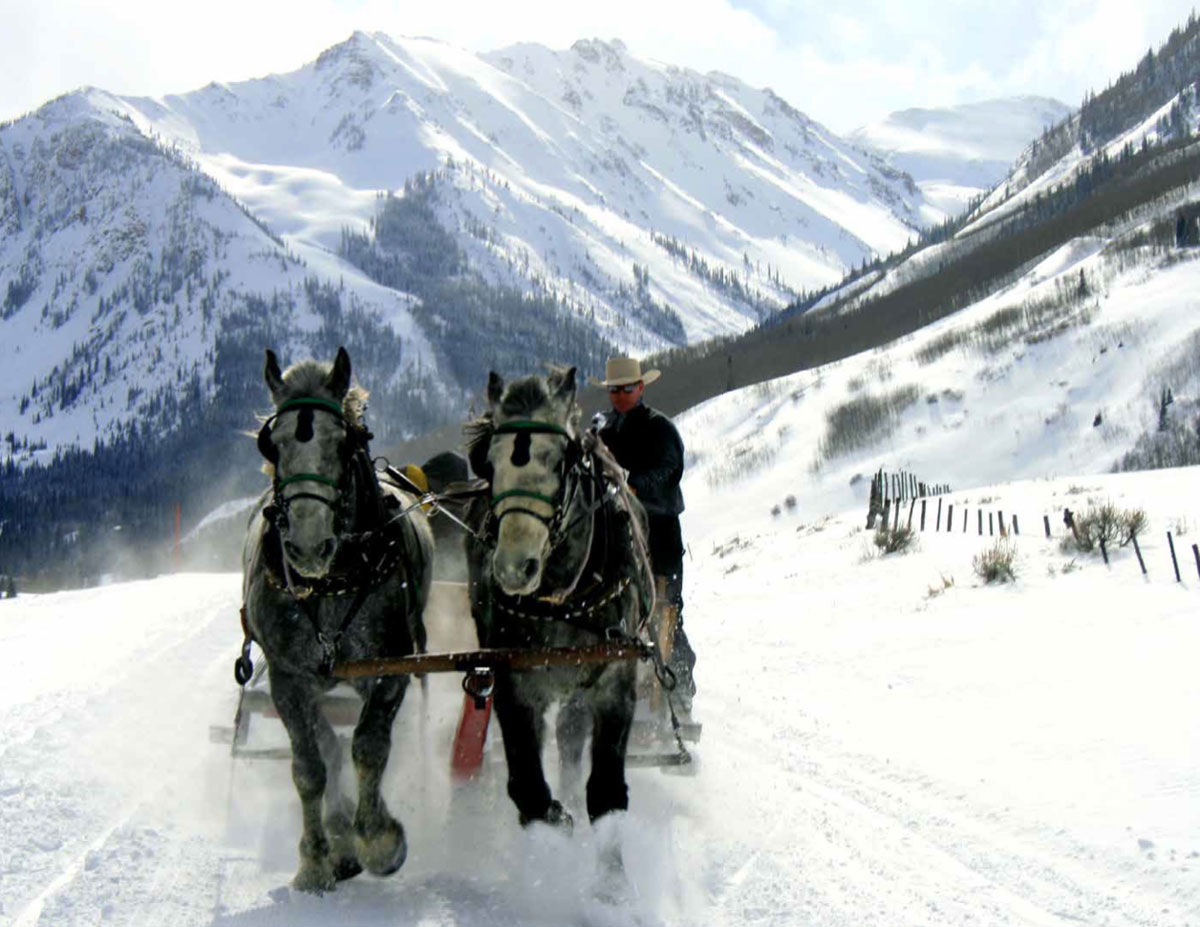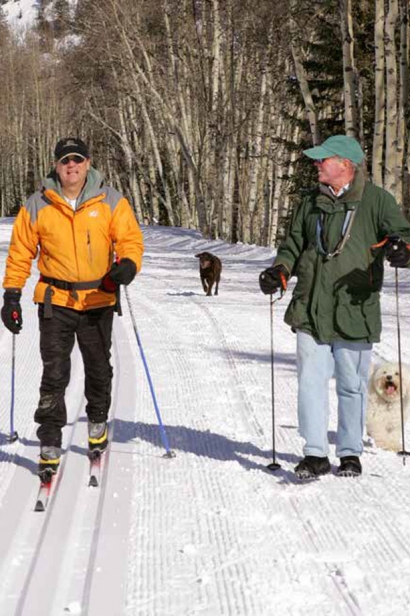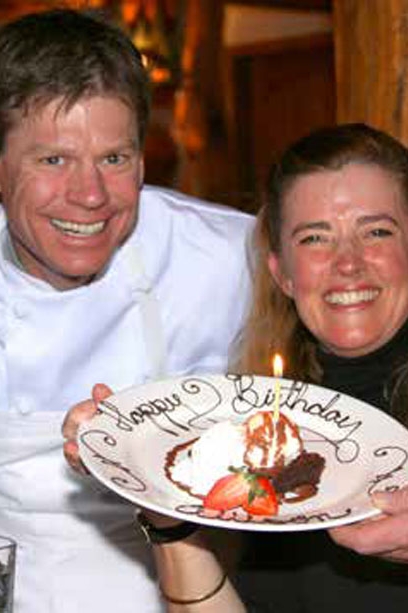Experience Pine Creek Cookhouse, A Mountain Bistro Worth Writing Home About
Near the end of the Castle Creek Road the valley opens to the rugged spine of the Elk Range. Two popular trailheads—American Lake and Cathedral Lake—draw thousands of hikers here each year. The next stop is the Pine Creek Cookhouse, one of Aspen’s most cherished restaurants.
For many the Cookhouse has become a generational tradition reaching back over 45 years. For those who discover it anew there comes instant appreciation for a well-polished gem in the heart of the Colorado Rockies. At close to 10,000 feet above sea level, the Cookhouse reigns as a literal high point for American alpine cuisine.
The original Cookhouse was part of a 1960s mountaineering school—The Ashcrofters—where Dave and Sherry Farney taught boys about life in the mountains. The original Cookhouse was the dining hall where many a camper satisfied big mountain appetites. Things have changed dramatically since those days, all except the big mountain appetites. They still get satisfied at the Pine Creek Cookhouse, only the fare is far more sophisticated than camp grub.
After The Ashcrofters closed down in the mid-’70s, the Cookhouse was taken over by Krisi and Greg Mace. They served Krisi’s ethnic Hungarian cooking with a complement of Mace Family delicacies derived from Toklat, just down the road. It was the Mace family that settled Ashcroft after World War II when Stuart, the family patriarch, ran sled dog teams as a tourist attraction.
John Wilcox, an independent TV and film producer, bought the Ashcroft Ski Touring Center (now known as Ski Ashcroft) from the Ted Ryan family and the Greg Mace estate in 1986. For 26 years he has fashioned the Cookhouse into a prized destination. While summers allow car access, winter visitors ski in on trails or ride a sleigh drawn by teams of Belgian and Percheron draft horses.
Wilcox recalls the inaugural sleigh ride to the Cookhouse when Ted Ryan paid his last visit. “Ted stood up in the sleigh—he was on oxygen then—and he realized the magic of riding behind a team of beautiful horses. Before then, only skiers were allowed to the Cookhouse.”
The original one-room shed-like building seated only 20. After Wilcox acquired the property he more than doubled the capacity. That building burned down in April 2003, but by autumn there was a new Cookhouse built with rustic logs into what feels like a roomy, welcoming lodge.
“It amazes me when people come in and start snapping pictures,” says Wilcox, “and they do the same outside. I’ve been to a lot of beautiful places in the world, but the Cookhouse has outstanding views. And the Ryan property has been protected by the Nature Conservancy since 1983. That was always part of Ted’s original vision.”
When executive chef Chris Keating took over the kitchen in 2009, the Cookhouse became credible as an epicurean venue for American alpine cuisine, a natural fit for a mountain hideaway at the end of the road.
Keating, who fell in love with Colorado on a ski trip as a boy, polished his skills at two of Aspen’s top hotel restaurants at The Little Nell and Hotel Jerome. “What a treat it was to go backcountry skiing in the Elk Mountains, ski up to the door of the Cookhouse, throw off my pack and walk into this dining experience,” recalls Keating, who was a customer before he became chef and general manager.
“Now I make sure the guests are happy, that they forget what is going on in the world and instead take in the natural beauty. I do everything I can to provide a natural experience, like buying line-caught river salmon that’s 48 hours out of the water and elk that roam free in the La Sal Mountains of Utah. We provide an unprecedented product here.”
Adds Wilcox, “The sustainability movement and growth of local produce has given us the opportunity to continue our theme for having healthy, local food. It may cost a little more, but it’s so fresh it’s worth it. You can really taste the difference.”
The views make everything taste better, suggests Keating. “It’s like when you’re out camping in the woods and you taste the best piece of cheddar cheese on a cracker you’ve ever had. Here it’s about feeling the wind and the sun. It’s about what Mother Nature has to offer in a calming experience from gazing out the windows at peaks covered with snow or bright with autumn colors. There’s a spirit to this place. I see the smiling guests and I’m just as happy as they are. The whole staff feels that way.”
Allison Spayd is a server at the Cookhouse whose Spradley Farms on nearby Missouri Heights provides the Cookhouse fresh greens and farm eggs. She sees the Cookhouse as a place of high energy, a true complement to the mountains.
“Visits here are usually coupled with outdoor adventures—a hike to Cathedral or American lakes, or ski touring. People come into the Cookhouse feeling energized. Wintertime here is absolutely magical because you can’t access it by car. You have to ski or take the horse-drawn sleigh. People leave here feeling like they’ve had an amazing experience. And they have.”
GO FIND IT!
Pine Creek Cookhouse
11399 Castle Creek Road, Ashcroft
970.925.1044
(Lunch reservations are recommended/dinner reservations are required.)
Recipes Courtesy of Chef Chris Keating, Pine Creek Cookhouse
Farro Kale Salad
3 cups cooked farro (in lightly salted boiling water until done)
1 cup chopped apricots, cherries and cranberries (evenly mixed)
1 cup toasted pine nuts
1 cup finely diced red onion (1/8-inch dice)
2 cups small-diced Roma tomatoes (no seeds)
1 cup chopped parsley-thyme blend (85% parsley/15% thyme)
½ cup balsamic vinegar
2 cups olive oil
2 pounds kale, washed, lightly blanched, then chopped fine (about ¼-inch dice)
Salt and pepper to taste
1. Mix cooked farro with all ingredients except kale.
2. Add kale and mix. Adjust seasoning as needed. Serve chilled. Serves approximately 6 (1 cup) portions.
Glazed Carrots
My son Matthew loves these! If the carrots are from the Roaring Fork area chances are they are short and stubby. Leave them whole with a short green stub on the end; it adds a natural character to your plate presentation whether the carrots are plated individually or family style.
12 short stubby local garden carrots, washed thoroughly (unpeeled or peeled)
2 cups water
2 tablespoons unsalted butter
2 tablespoons local honey
Salt and pepper
3 sprigs thyme
1. Bring the water, butter and honey to a boil; lightly season with salt and pepper. Add the thyme and carrots; cover and simmer until done. The liquid will cook down and glaze the carrots with deliciousness! Serves 6.
Olive Oil Fork-Mashed Potatoes
This recipe is a very easy, delicious and healthy alternative to the traditional butter-and-cream mashed potatoes.
6 Yukon Gold potatoes (or any potato from your garden), washed and unpeeled
1 gallon water for cooking
2 cups extra-virgin olive oil
3 tablespoons chopped parsley
Salt and pepper
1. Place whole potatoes in water and simmer until easily crumbled with a fork. Drain and allow to dry for about 1 minute.
2. Using a fork, mash the potatoes, adding olive oil as needed to keep them moist but do not over-saturate with oil. Add the parsley; season with salt and pepper and serve. Serves 4−6.







